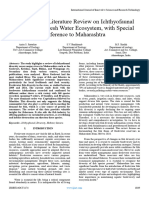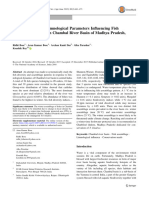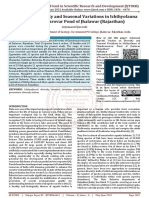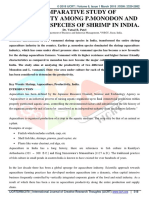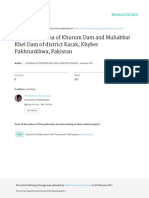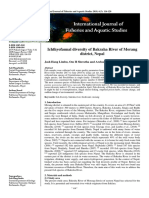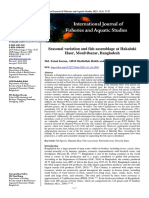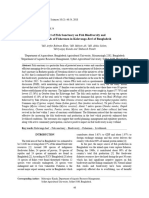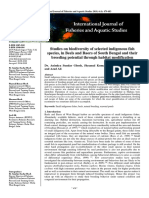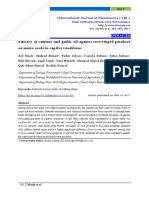Studies On Fresh Water Ichthyofauna of River Satluj at Syphon Mailsi, Punjab, Pakistan
Studies On Fresh Water Ichthyofauna of River Satluj at Syphon Mailsi, Punjab, Pakistan
Uploaded by
Adnan AhmedCopyright:
Available Formats
Studies On Fresh Water Ichthyofauna of River Satluj at Syphon Mailsi, Punjab, Pakistan
Studies On Fresh Water Ichthyofauna of River Satluj at Syphon Mailsi, Punjab, Pakistan
Uploaded by
Adnan AhmedOriginal Title
Copyright
Available Formats
Share this document
Did you find this document useful?
Is this content inappropriate?
Copyright:
Available Formats
Studies On Fresh Water Ichthyofauna of River Satluj at Syphon Mailsi, Punjab, Pakistan
Studies On Fresh Water Ichthyofauna of River Satluj at Syphon Mailsi, Punjab, Pakistan
Uploaded by
Adnan AhmedCopyright:
Available Formats
Journal of Entomology and Zoology Studies 2017; 5(4): 238-240
E-ISSN: 2320-7078
P-ISSN: 2349-6800
JEZS 2017; 5(4): 238-240
Studies on fresh water ichthyofauna of river
© 2017 JEZS Satluj at syphon Mailsi, Punjab, Pakistan
Received: 15-05-2017
Accepted: 16-06-2017
Qazi Adnan Ahmad Qazi Adnan Ahmad, Muhammad Abrar, Sarfraz Hussain, Zahid Farooq
Biology Lab, University
Community College, GC
and Muhammad Anwar Iqbal
University, Faisalabad, Pakistan
Abstract
Muhammad Abrar The present study was conducted to determine the fish fauna of Satluj River at Mailsi Syphon, situated in
Department of Zoology, GC South Punjab Pakistan. The survey was conducted from 2012 to 2013 at selected sampling sites (both
University, Faisalabad, Pakistan upstream and downstream) to discover fish diversity and their distribution pattern. The ichthyofauna
observed during the study; 18 fish species that were categorized into seven families and six orders. In
Sarfraz Hussain terms of fish species, Cyprinidae was the dominant family which includes the following eight species:
Department of Zoology, GC Gibelion catla, Cirrhinus mrigala, Ctenopharyngodon idella, Cyprinus carpio, Hypophthalmichthys
University, Faisalabad, Pakistan
molitrix, Labeo calbasu, Labeo rohita and Macrotepis putitora. The present study was useful in
providing the baseline information on species distribution and diversity. The work was initiated to make
Zahid Farooq
Punjab Wildlife and Parks
the checklist of fish fauna of River Satluj at Mailsi Syphon; one of the neglected site by researchers. If
Department, Government of prompt and relevant mitigation measures will not adopted, the biodiversity of the area be severely
Punjab, Pakistan affected.
Muhammad Anwar Iqbal Keywords: Fresh water, Ichthyofauna, wetland, Satluj
Department of Zoology,
Women University of Azad 1. Introduction
Jammu and Kashmir, Bagh, Pakistan being an agriculture country has world’s largest irrigation System. This comprises
AJK, Pakistan mainly dams, barrages, and a network of irrigation canals and waterways [1]. It is considered
these three dams; Tarbela, Mangla and Hub are the largest ones. [1, 4, 13]. The prime function to
construct these dams was to regulate and channelize river water for energy production, and to
supply water for irrigation in Punjab and Sindh, as agriculture is the pillar of Pakistan’s
economy. Besides these irrigation canals, several link canals connect the rivers [13]. These link-
canals are mainly used to shift water from one river to another. Some of the larger barrages are
the Chashma, Taunsa, Merala, Rasul, Qadirabad, Guddu and Sukkur Barrages [1].
In Pakistan, 14 million ha are irrigated. There are three major reservoirs, plus 19 barrages, 12
interlink canals and 43 independent irrigation command areas. The total length of main canals
is 58 500 km [1, 2]. About 79 percent of the total wheat crop comes from irrigated fields. None
of the major dams include fish passes, but some barrages have fish passes which, however, are
largely non-functional. Most pumping stations have no fish protection devices and where these
are present, they do not function well. In the year 2000, 144 000 tonnes of fish were captured
from rivers, reservoirs, natural lakes and irrigation canals; 36 000 tonnes were produced in
aquaculture, and about 75 percent of these were produced in fish ponds fed by irrigation canals [2].
This study is premier in a way that no other work has been conducted before to cover diversity
and conservation for the fish fauna of River Satluj at Syphon Mailsi.
2. Materials and Methods
2.1 Study Area
The princely states of Bahawalpur, during the 20th century with the British India Government,
made three major water barrages; under project title ‘Satluj Valley Project’. These were
Suleimanki Headworks, Islam Barrage and Punjnad Headworks. In this study the authors
intended to find the ichthyofaunal diversity and threats posing due to various anthropogenic
activities of study site wh ich was constructed in 1965 after Indus Water Treaty. The main
Correspondence function of Mailsi Syphon is to regulate supply of river water and control flood. This site has a
Qazi Adnan Ahmad complex of terrestrial and aquatic ecosystems because it retains features of both these types.
Biology Lab, University
Community College, GC
Pakistan exhibits a larger fresh water reservoir ecosystem. Out of them, River Satluj is one of
University, Faisalabad, Pakistan the main eastern tributary of the Indus River.
~ 238 ~
Journal of Entomology and Zoology Studies
Length of river Satluj in Pakistan is approximately 329 miles. rohita and Macrotepis putitora.
This river is included along other two rivers whose water The families Mastacembelidae, Notopteridae and Sisoridae
management has been given to India under an accord called were observed least with respect to species diversity, because
Indus Water Treaty. Pakistan with the help of World Bank has one species each belonging these families was observed
made water reservoirs and link canals to use the river beds namely: Mastacembelus armatus, Gudusia chapra and
these three eastern rivers. Bagarius bagarius.
Commercially important fish species captured at Maislsi
2.2 Methodology Syphon of Satluj River include Cirrhunus mrigala, Cirrhinus
Both direct and indirect method was applied to collect the reba, Gibelion catla, Catla catla, Labeo rohita, Labeo
data. Fish sampling was done randomly on monthly basis calbasu, Ctenopharyngodon idella and Hypophthalmichthys
from Jan 2012 to Dec 2013. The research site of Syphon molitrix.
Mailsi was explored extensively both upstream and
downstream. The fish specimens were collected with the help 4. Discussion
of local fishermen and fish contractors by using different The diversity of fish fauna observed in the present study was
fishing nets. Fish species were identified by the literature lower in other studies conducted in fresh water reservoirs.
available. Mirza [5-9, 11, 12] Talwar and Jhingram [16]. However, it is pertinent to mention here that literature on the
Collections were made from an area 500 meters upstream and Satluj is not available to support or oppose our present results.
downstream from each locality and along both banks of the The results of the present studies are not in accordance with
river. the work of others who reported fish diversity at Taunsa
Barrage with 22 species and 42 respectively [4] but these are in
3. Results consistent with studies conducted on Neelum River (a
Among the total fish fauna of Pakistan, 86 species (8 exotic tributary of River Jehlum) [10].
and 78 indigenous) have been identified as “species of special Fresh water ecosystems are being considered a good habitat
importance” [3, 14] for several of fish species have been introduced for fish
In the present study, the authors found 18 fish species (with culture. [15] A study conducted on Indus River indicated70 fish
406 individual counts) that were categorized into seven species were present during the course of investigation [15]
families and six orders; Sperata sarwari, Rita rita, Wallago Following threats were observed at the study site : a) Increase
attu, Bagarius bagarius, Channa Punctatus, Colisa fasciata, in hazardous chemicals (POPs) due to extreme loads of
Oreochromis mossambica, Heteropneustes fossilis, Gibelion fertilizers and pesticides in agricultural land b) Fish diseases
catla, Cirrhinus mrigala, Ctenopharyngodon idella, Cyprinus due to decrease in water, and growing absorption of waste
carpio, Hypophthalmichthys molitrix, Labeo calbasu, Labeo matters c) over and illegal fishing for marketing.
rohita, Macrotepis putitora, Mastacembelus armatus, and The present study was useful in providing baseline
Gudusia chapra information on species distribution and diversity. The work
In terms of fish species, Cyprinidae was the dominant family was initiated to make the checklist of fish fauna of River
which includes the following eight species: Gibelion catla, Satluj at Mailsi Syphon; one of the neglected site by
Cirrhinus mrigala, Ctenopharyngodon idella, Cyprinus researchers.
carpio, Hypophthalmichthys molitrix, Labeo calbasu, Labeo
Fig. Study Area Map
~ 239 ~
Journal of Entomology and Zoology Studies
Table 1: Fish Diversity at Study Area
S. No. Scientific Name Common Name Individual Counts Relative Abundance
1 Sperata sarwari Singhari 34 0.083743842
2 Rita rita Khaga 12 0.02955665
3 Wallago attu Mullee 17 0.041871921
4 Bagarius bagarius Fauji Khagga 21 0.051724138
5 Channa Punctatus Daula 9 0.022167488
6 Colisa fasciata Bari kanghi 2 0.004926108
7 Oreochromis mossambica Tilapia 3 0.007389163
8 Heteropneustes fossilis Singhi 5 0.012315271
9 Gibelion catla Theila 51 0.125615764
10 Cirrhinus mrigala Mori 47 0.115763547
11 Ctenopharyngodon idella Grass Carp 32 0.078817734
12 Cyprinus carpio Gulfam 24 0.0591133
13 Hypophthalmichthys molitrix Silver Carp 46 0.113300493
14 Labeo calbasu Kalbans 18 0.044334975
15 Labeo rohita Rohu 73 0.179802956
16 Macrotepis putitora mahseer 3 0.007389163
17 Mastacembelus armatus Bam 6 0.014778325
18 Gudusia chapra Palli 3 0.007389163
Total = 406
4. Conclusion 10. Mirza MR, Ejaz A. Fishes of the River Neelum with the
The result of present study showed that fish diversity of river record of Botia birdi and Tryplophysa microps from
Sutluj at Mailsi Syphon was low as compared to other local Azad Kashmir. Pakistan Journal of Zoology. 1992;
rivers of Pakistan like Indus, Jehlum and Chenab. It was 24:168-169.
observed during study that ichthyofaunal diversity of river 11. Mirza MR. Freshwater fishes in Pakistan. Urdu Science
Satluj was decreasing gradually due to decrease water flow, Board, Lahore (in Urdu, with a Checklist of Scientific
anthropogenic activities, overuse of agrochemicals (being name in English), 1990.
cotton growing area) and illegal fishing, threatening the fish 12. Mirza MR, Sandhu IA. Fishes of the Punjab, Pakistan.
fauna to seriously. Discussion with the locals revealed that the Polymer Publications, Pakistan, 2007.
fish diversity has reduced up to alarming level in recent 20 13. Nasim A. The use of Irrigation System for Sustainable
years due to reduced water flow and aforementioned facts. If Fish Production in Pakistan. Pakistan Agriculture
prompt and relevant mitigation measures will not adopted, the Research Council, Islamabad, 2003.
biodiversity of the area be severely affected. 14. Rafique M, Khan NUH. Distribution and status of
significant freshwater fishes of Pakistan. Records
5. Acknowledgement Zoological Survey Pakistan. 2012; 21:90-95.
The authors are grateful to the local fishermen and inhabitants 15. Shah IH. Fish and fisheries of Mangla reservoir, a
who supported during this study. review. Biologia, 1996; 42:37-42.
16. Talwar PK, Jhingran AG. Inland fishes of India and
6. References adjacent countries. Oxford and IBH Publishing Co., New
1. CBD. First National Report on Biodiversity, Pakistan; Delhi, India, 1991, 2.
Ministry of Environment Protection and Climate Change,
2000.
2. Iqbal Z, Pervaiz K, Javed MN. Population dynamics of
tor macrolepis (Teleostei: Cyprinidae) and other fishes of
Attock region, Pakistan. Canadian Journal of Pure and
Applied Sciences. 2013; 7:2195-2201.
3. IUCN. Status of Fish Fauna of Pakistan, 2011.
4. Khan AM, Shakir HA, Khan MN, Abid M, Mirza MR.
Ichthyofaunal survey of some fresh water reservoirs in
Punjab. Journal of Animal and Plant Sciences. 2008;
18:151-154.
5. Mirza MR. Freshwater fishes and zoogeography of
Pakistan. Bijdr. Dierk. 1975; 45:143-180.
6. Mirza MR. History of ichthyology in Pakistan. Biologia,
1978; 24:305-348.
7. Mirza MR. The systematics and zoogeography of the
freshwater fishes of Pakistan and Azad Kashmir.
Proceedings of Ist Pakistan Congress of Zoology. 1980;
1:1-44
8. Mirza MR. Distribution of Freshwater Fishes in Pakistan
and Azad Kashmir. Proceedings of Seminar Aquaculture
Development Pakistan, 1993, 1-45.
9. Mirza MR, Saeed TB, Hussain S. Checklist of the fishes
of Mangla Lake. Science Khyber, 1989; 2:287-292.
~ 240 ~
You might also like
- SCA Barista Latte Art Standard Worksheet EN A4Document2 pagesSCA Barista Latte Art Standard Worksheet EN A4avila83_14No ratings yet
- FISH_FAUNA_OF_RIVER_CHenabDocument9 pagesFISH_FAUNA_OF_RIVER_CHenabRiyana GuptaNo ratings yet
- 1 Ijzrdec20171Document10 pages1 Ijzrdec20171TJPRC PublicationsNo ratings yet
- Review On Fresh Water Fish Diversity of Maharashtra (India)Document7 pagesReview On Fresh Water Fish Diversity of Maharashtra (India)Pawara RNo ratings yet
- Native Species in Kampar Kanan River, Riau Province IndonesiaDocument4 pagesNative Species in Kampar Kanan River, Riau Province IndonesiananaNo ratings yet
- IOSRPaperDocument7 pagesIOSRPaperabinashpadunNo ratings yet
- A Systematic Literature Review on Ichthyofaunal Diversity in Fresh Water Ecosystem, with Special Reference to MaharashtraDocument7 pagesA Systematic Literature Review on Ichthyofaunal Diversity in Fresh Water Ecosystem, with Special Reference to MaharashtraInternational Journal of Innovative Science and Research TechnologyNo ratings yet
- Fish and Inland FisheriesDocument13 pagesFish and Inland Fisheriesprakasharunjha16No ratings yet
- Present and Future For Production in Cages and Enclosures in IndiaDocument6 pagesPresent and Future For Production in Cages and Enclosures in IndiaAnjuNo ratings yet
- Fish Diversity and Limnological Parameters Influencing Fish Assemblage Pattern in Chambal River Basin of Madhya Pradesh, IndiaDocument13 pagesFish Diversity and Limnological Parameters Influencing Fish Assemblage Pattern in Chambal River Basin of Madhya Pradesh, IndiaDARSHAN KUMAR TNo ratings yet
- Report On Degraded Ecosystem Pashan LakeDocument13 pagesReport On Degraded Ecosystem Pashan LakeArash AhmadNo ratings yet
- Anonymus-Fish Diversity of Siluridae From Central Mahakam-Full Paper-OkDocument13 pagesAnonymus-Fish Diversity of Siluridae From Central Mahakam-Full Paper-OkwahyudewantorogemaNo ratings yet
- Feeding Paper For PDF PublishedDocument21 pagesFeeding Paper For PDF PublishedRakesh KumarNo ratings yet
- Biodiversity Assessment of Kodar Reservoir of Chhattisgarh: SS Mishra, S Mohanty, MS Chari and HK VardiaDocument5 pagesBiodiversity Assessment of Kodar Reservoir of Chhattisgarh: SS Mishra, S Mohanty, MS Chari and HK VardiaHead copperNo ratings yet
- Studies On Diversity and Seasonal Variations in Ichthyofauna of Chandrasarovar Pond of Jhalawar RajasthanDocument5 pagesStudies On Diversity and Seasonal Variations in Ichthyofauna of Chandrasarovar Pond of Jhalawar RajasthanEditor IJTSRDNo ratings yet
- Sandya Int 02 Journal FishDocument6 pagesSandya Int 02 Journal FishDARSHAN KUMAR TNo ratings yet
- Impact of Physical Chemical and Climatic PDFDocument11 pagesImpact of Physical Chemical and Climatic PDFc.kandeepanNo ratings yet
- 3 2 84 DR JagadeeshwarDocument6 pages3 2 84 DR JagadeeshwardrtjcouNo ratings yet
- A Case Study On Aquatic Biodiversity and Its ConseDocument10 pagesA Case Study On Aquatic Biodiversity and Its ConseYouTuBoy AmanNo ratings yet
- Fish Diversity Habitat Ecology and Their ConservatDocument15 pagesFish Diversity Habitat Ecology and Their Conservatkaleemmansoor9No ratings yet
- The Chalan Beel in Bangladesh Habitat AnDocument18 pagesThe Chalan Beel in Bangladesh Habitat AnHM Hashem AliNo ratings yet
- Dinamika Populasi Sumber Daya Ikan Layur LepturacaDocument10 pagesDinamika Populasi Sumber Daya Ikan Layur LepturacakastrinNo ratings yet
- Environmental Variables and Fisheries Diversity of PDFDocument7 pagesEnvironmental Variables and Fisheries Diversity of PDFjash hang limbuNo ratings yet
- Rahman MA Et Al 2008Document8 pagesRahman MA Et Al 2008rodolfoverdidajrNo ratings yet
- Mahseer Breeding and Conservation and Possibilities of Commercial Culture. TDocument18 pagesMahseer Breeding and Conservation and Possibilities of Commercial Culture. TRajpal Singh KochharNo ratings yet
- IJCRTDRBC078 HowtomDocument9 pagesIJCRTDRBC078 Howtompro officialNo ratings yet
- Freshwater Nematodes From Matang Wild-Life and Kubah National Parks Rivers, Sarawak, MalaysiaDocument6 pagesFreshwater Nematodes From Matang Wild-Life and Kubah National Parks Rivers, Sarawak, Malaysiayunike ihza07No ratings yet
- Fish Fauna of Muhabbt Khel Dam (Lake Kana) District Karak Khyber Pakhtunkhwa, PakistanDocument4 pagesFish Fauna of Muhabbt Khel Dam (Lake Kana) District Karak Khyber Pakhtunkhwa, PakistanShafi Ullah GulNo ratings yet
- Pakistan Vertebrate FaunaDocument9 pagesPakistan Vertebrate FaunaNosheen MalikNo ratings yet
- The Biodiversity of Fish Fauna in GobardhanDas Pond (Saran District), North BiharDocument4 pagesThe Biodiversity of Fish Fauna in GobardhanDas Pond (Saran District), North BiharresearchparksNo ratings yet
- Habitat Use of Fishes in Streams of KMTRDocument14 pagesHabitat Use of Fishes in Streams of KMTRArunachalamNo ratings yet
- Markad 2442024 ACRI114742Document8 pagesMarkad 2442024 ACRI114742rathan kumarNo ratings yet
- Fish Diversity, Composition and Invasion of Exotic Fishes in River Yamuna Under Altered Water Quality ConditionsDocument8 pagesFish Diversity, Composition and Invasion of Exotic Fishes in River Yamuna Under Altered Water Quality ConditionsHarshad SavantNo ratings yet
- Qualitative and Quantitative Analysis of Zooplankton Along Veraval Coast, GujaratDocument6 pagesQualitative and Quantitative Analysis of Zooplankton Along Veraval Coast, Gujaratjustexploring281No ratings yet
- Qualitative and Quantitative Study of Zooplankton From Fresh Water Tanks of Kolhapur District, (Maharashtra)Document8 pagesQualitative and Quantitative Study of Zooplankton From Fresh Water Tanks of Kolhapur District, (Maharashtra)SameerNo ratings yet
- Ichthyofaunal Diversity of Bakraha River of Morang District, NepalDocument5 pagesIchthyofaunal Diversity of Bakraha River of Morang District, NepalJash hang limbuNo ratings yet
- Seasonal Variation and Fish Assemblage at Hakaluki Haor, Moulvibazar, Bangladesh.Document11 pagesSeasonal Variation and Fish Assemblage at Hakaluki Haor, Moulvibazar, Bangladesh.Md. Faisal ImranNo ratings yet
- 88 ArticleText 296 1 10 202007021Document11 pages88 ArticleText 296 1 10 202007021Shayne BonayonNo ratings yet
- Kondisi Habitat Dan Keragaman Nekton Di Hulu Daerah Aliran Sungai Wampu, Kabupaten Langkat, Provinsi..Document11 pagesKondisi Habitat Dan Keragaman Nekton Di Hulu Daerah Aliran Sungai Wampu, Kabupaten Langkat, Provinsi..PPIC CDANo ratings yet
- Impact of Fish Sanctuary On Fish BiodiveDocument9 pagesImpact of Fish Sanctuary On Fish BiodiveZahangir AlomNo ratings yet
- Zoology - Ijzr - Spatial Occurrence and Distribution of Ascidian Fauna Along The - Abdul Jaffar AliDocument8 pagesZoology - Ijzr - Spatial Occurrence and Distribution of Ascidian Fauna Along The - Abdul Jaffar AliTJPRC PublicationsNo ratings yet
- Comparative feeding ecology of two fish species bluestripe herring, Herklotsichthys quadrimaculatus Ruppel (Clupeidae) and big eye scad, Selar crumenophthalmus Bloch (Clupeidae) caught in the stilt fishery in southern Sri LankaDocument7 pagesComparative feeding ecology of two fish species bluestripe herring, Herklotsichthys quadrimaculatus Ruppel (Clupeidae) and big eye scad, Selar crumenophthalmus Bloch (Clupeidae) caught in the stilt fishery in southern Sri LankaProf. U.P.K. Epa - University of KelaniyaNo ratings yet
- Kualitas AIr Sungai KlawingDocument9 pagesKualitas AIr Sungai KlawingMas DalipNo ratings yet
- Studies On Biodiversity of Selected Indigenous Fish Species, in Beels and Baors of South BengalDocument5 pagesStudies On Biodiversity of Selected Indigenous Fish Species, in Beels and Baors of South BengalashisbhuniyaNo ratings yet
- 15.Eng-Fish Fauna of Shree Sharnabasveshwara Lake-ManjunathDocument4 pages15.Eng-Fish Fauna of Shree Sharnabasveshwara Lake-ManjunathImpact JournalsNo ratings yet
- Chilika LakeDocument23 pagesChilika LakeER.SAVINDRA KUMAR VAGHELANo ratings yet
- Statistical Analysis of Freshwater Fishes of Head Khanki, Punjab, PakistanDocument9 pagesStatistical Analysis of Freshwater Fishes of Head Khanki, Punjab, PakistanMuhammadUmairNo ratings yet
- E Paper Published On Env. & EcologyDocument9 pagesE Paper Published On Env. & EcologyMrigangka MalakarNo ratings yet
- Aquaculture Excursions Report_DebjitDocument30 pagesAquaculture Excursions Report_DebjitzjnxwcnfptNo ratings yet
- Livelihood AssessmentDocument14 pagesLivelihood AssessmentMazharul SajeebNo ratings yet
- Fisheries Resources 2Document34 pagesFisheries Resources 2Balaji0% (1)
- Impact of Sanctuary On Fish BiodiversityDocument9 pagesImpact of Sanctuary On Fish BiodiversityZahangir AlomNo ratings yet
- Fish Biodiversity and Conservation Status of The Dhepa River Sanctuary in Protection and Restoration of Threatened Fishes of The Northwest BangladeshDocument8 pagesFish Biodiversity and Conservation Status of The Dhepa River Sanctuary in Protection and Restoration of Threatened Fishes of The Northwest BangladeshOpenaccess Research paperNo ratings yet
- Fresh Water, Brackish and Marine Water Fish Culture in IndiaDocument68 pagesFresh Water, Brackish and Marine Water Fish Culture in IndiaOps Traffic DigitalNo ratings yet
- P.HD WORKDocument13 pagesP.HD WORKtamtagaurav4325No ratings yet
- Benita's Excursion reportDocument35 pagesBenita's Excursion reportzjnxwcnfptNo ratings yet
- Certificate: Kmes'S G.M Momin Women'S CollegeDocument9 pagesCertificate: Kmes'S G.M Momin Women'S CollegeKrishna YeldiNo ratings yet
- 2013 InfoF State of Fisheries Bio-Diversity in BangDocument4 pages2013 InfoF State of Fisheries Bio-Diversity in Bangsubratasrkr59No ratings yet
- E Pathshala File 402642449945Document7 pagesE Pathshala File 402642449945Aijaz AhmadNo ratings yet
- Guardians of the Sea: Vital Coral Network of the Indian OceanFrom EverandGuardians of the Sea: Vital Coral Network of the Indian OceanNo ratings yet
- Fishes of Tropical Estuarine Ecosystems : Diversity and AdaptationsFrom EverandFishes of Tropical Estuarine Ecosystems : Diversity and AdaptationsNo ratings yet
- Biodiversity and Conservation of Two Important Wetlands of River Satluj With Special Reference To AvifaunaDocument3 pagesBiodiversity and Conservation of Two Important Wetlands of River Satluj With Special Reference To AvifaunaAdnan AhmedNo ratings yet
- Assessment of Water Fowl Diversity of River Chenab, PakistanDocument7 pagesAssessment of Water Fowl Diversity of River Chenab, PakistanAdnan AhmedNo ratings yet
- Assessment of Status, Diversity and Threats of Wetland Birds of Bathi Lake, Doddabathi Village, Davanagere District, Karnataka, IndiaDocument6 pagesAssessment of Status, Diversity and Threats of Wetland Birds of Bathi Lake, Doddabathi Village, Davanagere District, Karnataka, IndiaAdnan AhmedNo ratings yet
- 1564623977PJZ 51 5 1943-1952 PDFDocument10 pages1564623977PJZ 51 5 1943-1952 PDFAdnan AhmedNo ratings yet
- Biometric Traits and Ecology of Sichel, Pelecus Recent Status in The Middle Flow of The Danube River Tributaries (Slovenia and Croatia)Document9 pagesBiometric Traits and Ecology of Sichel, Pelecus Recent Status in The Middle Flow of The Danube River Tributaries (Slovenia and Croatia)Adnan AhmedNo ratings yet
- IJB V10No6 p101 107Document7 pagesIJB V10No6 p101 107Adnan AhmedNo ratings yet
- Daily Food-Intake and Activity Patterns of Wintering Common Cranes (Grus Grus) in Wetlands of Khushab and Bahawalnagar Punjab, PakistanDocument6 pagesDaily Food-Intake and Activity Patterns of Wintering Common Cranes (Grus Grus) in Wetlands of Khushab and Bahawalnagar Punjab, PakistanAdnan AhmedNo ratings yet
- 8002 MCBXLRDocument24 pages8002 MCBXLRDave GildasNo ratings yet
- Essay - A Noiseless Patient SpiderDocument3 pagesEssay - A Noiseless Patient SpiderThalita Carvalho0% (1)
- Project Titles On Arduino - 2023-1Document22 pagesProject Titles On Arduino - 2023-1Ashok Sankurathri0% (1)
- Test 1 ESTDocument15 pagesTest 1 ESTshoushamoustafaNo ratings yet
- RESEARCHDocument9 pagesRESEARCHBhea Clarisse FerrerNo ratings yet
- Buderus Manuel Ductile PDFDocument133 pagesBuderus Manuel Ductile PDFjjjNo ratings yet
- Narokona Amp by P - TechDocument17 pagesNarokona Amp by P - TechMelvin QuinteroNo ratings yet
- UntitledDocument3 pagesUntitledShivam GoyalNo ratings yet
- Derivation of the scaling laws used in geotechnical centrifuge modelling-application of dimensional analysis and Buckingham Π theoremDocument16 pagesDerivation of the scaling laws used in geotechnical centrifuge modelling-application of dimensional analysis and Buckingham Π theoremPraveen SatheeshNo ratings yet
- Design of StairDocument7 pagesDesign of StairMainali IshuNo ratings yet
- Aibus Consortium AssignmentDocument3 pagesAibus Consortium Assignmentberlberl167% (3)
- Sukshma and Sthula VyayamaDocument1 pageSukshma and Sthula VyayamaKomal MandeNo ratings yet
- Tablas de Excel Sap 2000Document228 pagesTablas de Excel Sap 2000pedro moralesNo ratings yet
- Data Center Engineering OperationsDocument4 pagesData Center Engineering OperationsV. GrigorasNo ratings yet
- Heat Transfer Machines - 8 in 1 Combo Heat Press Machine Wholesale Trader From HyderabadDocument15 pagesHeat Transfer Machines - 8 in 1 Combo Heat Press Machine Wholesale Trader From HyderabadVenkata DineshNo ratings yet
- 6.9 Urban Data - Digital Interactive NotebookDocument11 pages6.9 Urban Data - Digital Interactive NotebookbopisnugsisfatNo ratings yet
- Beam Design ThumbruleDocument5 pagesBeam Design ThumbrulehipreyashNo ratings yet
- Group Project and Name List PDFDocument2 pagesGroup Project and Name List PDFIzzah 'AtirahNo ratings yet
- Green City, Clean Waters: Implementing Philadelphia's Combined Sewer Overflow Long Term Control Plan UpdateDocument57 pagesGreen City, Clean Waters: Implementing Philadelphia's Combined Sewer Overflow Long Term Control Plan UpdateKirk BarrettNo ratings yet
- a parody outline of history (戏谑历史)Document68 pagesa parody outline of history (戏谑历史)JingNo ratings yet
- 5 Antenna Relay Switch Iss 2 Ea5avlDocument2 pages5 Antenna Relay Switch Iss 2 Ea5avlJack RodriguezNo ratings yet
- Hemorrhoids Treatment: All You Need To Know About Hemorrhoids, It's Causes, Symptoms and TreatmentDocument17 pagesHemorrhoids Treatment: All You Need To Know About Hemorrhoids, It's Causes, Symptoms and TreatmentPredrag TerzicNo ratings yet
- 10.1 - Resistance QP PDFDocument16 pages10.1 - Resistance QP PDFMuhammad Saif AmirNo ratings yet
- Cerjak Enzinger Pudar 39735Document18 pagesCerjak Enzinger Pudar 39735alok987No ratings yet
- The UniverseDocument2 pagesThe Universeapi-328735767No ratings yet
- Aquatic Insect Field GuideDocument19 pagesAquatic Insect Field GuideDfhjjNo ratings yet
- Chapter 4a STATICSDocument20 pagesChapter 4a STATICSIRDINA ZAKIRAH IZUDINNo ratings yet
- GG-Karrierdag 09Document28 pagesGG-Karrierdag 09Dem68No ratings yet
- SLMDocument7 pagesSLMRauven Jean Erodias FadriquelaNo ratings yet






